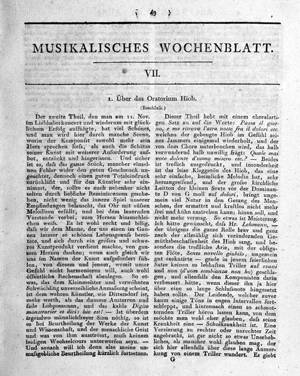Musikalisches Wochenblatt / Musikalische Monatsschrift
Includes:
Prepared by Ole Hass
Online only (2011)

In 1791, Johann Friedrich Reichardt (1752-1814), composer at the Berlin court, undertook to publish an educational music journal, which began as the Musikalisches Wochenblatt [Musical weekly], in twenty-four parts [Stücke], twelve of which made up one Heft. The journal was reduced to monthly publication renamed the Musikalische Monathsschrift [Musical monthly] during the second year. Each part of MWB includes a sheet music supplement consisting of short compositions, usually a one-page Lied, opera aria or instrumental piece. The weekly was edited by Friedrich Ludwig Aemilius Kunzen (1761-1817), co-founder of a concert series given at the Berlin inn “Stadt Paris,” and Johann Gottlieb Karl Spazier (1761-1806), a philosopher, writer and musical dilettante. The monthy was largely edited by Reichardt, who, with Spazier were the main contributors to both journals.
The “Vorbericht” [Introduction] to the first issue gives an outline of the content, a format adhered to throughout the publication's run: 1. Reviews of important musical works [books and compositions] from Germany, Italy, France and England; 2. Short announcements of noteworthy compositions from these countries; 3. Essays on theoretical, practical and poetic matters of music; 4. Reports on musical life in European centers; 5. Reports of fine musicians; 6. Biographies of noteworthy deceased musicians; 7. Poems, anecdotes, etc.; 8. Reviews of short songs and compositions.
The journal gives insight into contemporary musical life of Berlin: the Liebhaberkonzerte [Dilettante concerts], the concert series at the inn “Stadt Paris,” and performances of operas and church music (including Reichardt’s Concerts spirituels). Works reviewed include the operas Axur by Salieri, Olimpiade by Reichardt, Darius by Allessandri, Don Juan by Mozart, and the oratorio Hiob by Dittersdorf. Several reviews deal with musical life in Paris after the revolution. A writer from London reviews a performance of Handel’s oratorio Samson at the Drury Lane Theatre. Reviews of published music include the opera Aline, Königin von Golconda by J. A. P. Schulz. Letters offer information on musical life in Potsdam, Königsberg, Mannheim, Vienna, Prague, Copenhagen, and Rome, ten letters possibly written by Reichardt himself.
Biographies deal with the pianist Johann Samuel Schröter (translated from the English), F. L. Ae. Kunzen and Pergolesi (translated from Charles Burney). Reichardt contributes extensive corrections and additions to Gerber’s Lexicon der Tonkünstler, drawing on his own collection of sheet music, manuscripts and biographical knowledge of musicians. Excerpts from Eschenburg’s translations of Charles Burney’s A General History of Music appear in two installments.
The musical supplements include a romance from Salieri’s opera Axur, and two dance pieces from Reichardt’s opera Olimpiade. Other composers featured in the musical supplements are the journal’s editors, Kunzen and Spazier, as well as Johann Abraham Peter Schulz, Nicolas-Marie Dalayrac, Karl Friedrich Christian Fasch, the glass harmonica player Karl Leopold Röllig, Carl Friedrich Zelter, Johann Adam Hiller and Daniel Gottlob Türk.
The journal’s run ended in 1792, owing to a lack of public interest. In December 1792, all six Hefte were bound together and sold as the Studien für Tonkünstler und Musikfreunde, with an introduction by Reichardt and a list of contributors.
